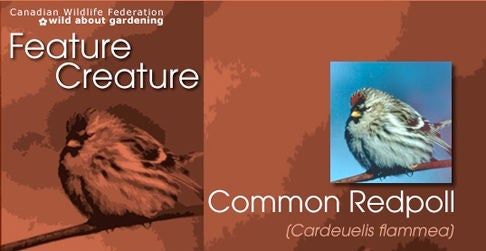
SCIENTIFIC NAME
Carduelis flammea
DESCRIPTION
At only 11-14 cm, the common redpoll is a small bird. A member of the finch family, this streaked bird can be difficult to distinguish from pine siskins. Redpolls are named for their red forehead but this is not always obvious, so look instead for the black patch on their chin to recognize them. To identify the sex of common redpolls look for the slight tinge of rose on the breasts of the males.
RANGE
Common Redpolls can be found year round in the territories (Yukon, Northwest and Nunavut) of Canada. Their breeding area takes them further north in those territories and over to Newfoundland and Labrador. Their winter migration pattern moves them further south across the provinces of Canada and northern United States.
HABITAT
Common redpolls are one of the most northern breeding finches, building their nests in the dwarfed willows, spruce, birch, or alders of subarctic forests or the scattered shrubs of northern tundra.
DIET
Redpolls subsist almost entirely on a diet of birch seeds. Then can eat up to 42 percent of their body mass every day. When food is scarce or unsafe to rest and eat they can store up to about 2 grams (0.07 oz.) of seeds in a stretchy part of their esophagus, enough for about a quarter of their daily energy requirement.
BEHAVIOUR
undefinedPRIMARY ECOSYSTEM ROLES
Photo Gallery

| Photo: Bill Marchel, Cornell Laboratory of Ornithology |
|
Redpolls are a member of the winter finches, a group of finches which breed in northern Canada, and so are generally only seen in southern, more populated areas during the winter. This group includes the redpolls, crossbills, siskins, and evening and pine grosbeaks. The winter finches are associated with "irruptions" or periodic invasions of areas south of their usual wintering grounds. These irruptions are thought to be caused by a season of good breeding (population growth) followed by a season of winter food shortages which forces the birds further south in search of food. Common redpolls tend to exhibit this irruptive behaviour on a fairly regular basis (generally every second year) in association with the production of catkins on birch and alder. When there is a poor crop of catkins in their wintering grounds redpolls head further south in great numbers. To survive the extreme cold of their normal wintering areas, the common redpoll has an interesting adaptation for feeding. A sac (diverticula) inside their throats allows them to store seeds temporarily. During times of cold weather, common redpolls will knock seeds to the ground, swoop down to pick them up, quickly storing the seeds in their throat sac, and escape to a more sheltered spot. This gives them the freedom to shell and eat their findings in greater warmth and safety. To attract redpolls to your garden, try planting birch trees to provide them with their favourite food. These friendly little birds also feed on alder, willow, elm, pine, and some berries. They will appear at feeders mid-winter in flocks with siskins and goldfinches. Fill feeders with niger or sunflower seeds and they will happily feed and chatter away. |
